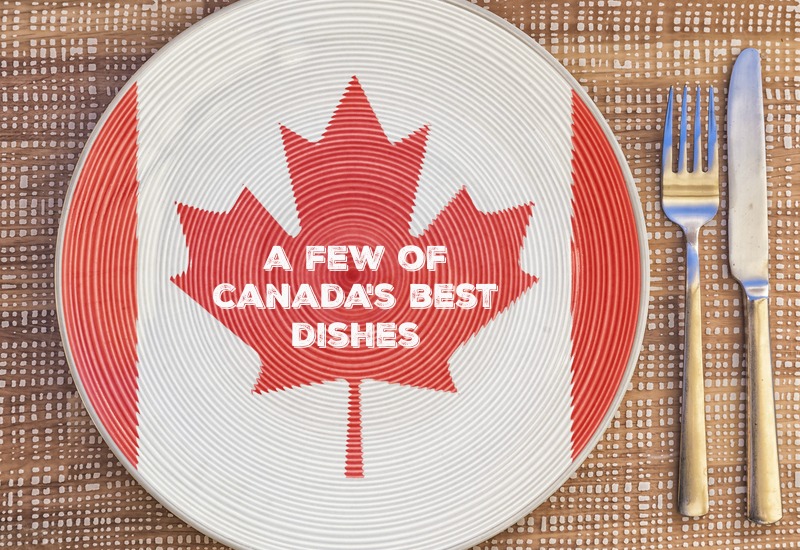
Canadian place setting via Shutterstock.
I’m a proud and grateful Canadian. I think most of us, whether newly arrived from other countries or raised in families that have lived here for generations, realise that we live in a special part of the world. This country boasts stunning landscapes, plentiful natural resources, a [mostly] harmonious blend of cultures, many bright, compassionate and resourceful citizens, and freedoms and privileges that are sadly lacking in many parts of the world. As much as I love to travel, I will always want to come home to ‘the true North’.
I thought it would be fun to take stock of a particularly enjoyable aspect of Canada’s heritage and culture… the FOOD! With such diverse climatic and cultural conditions across the country, a person could be forgiven for feeling that Canada doesn’t have a distinct food identity and native cuisine. But communities across the country do have many strong culinary traditions, and we owe it to ourselves to find out more about them! Let’s get started by dipping our virtual toe into the Pacific Ocean on BC’s west coast on this palate-pleasing coast-to-coast virtual tour of Canada.
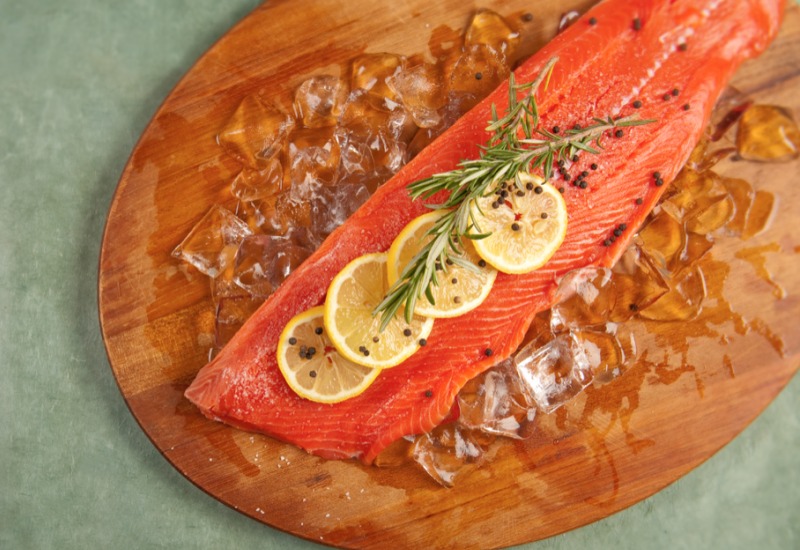
Sockeye Salmon Fillet. Photo courtesy RiverFresh Wild BC Salmon.
I doubt there’s a coastal community anywhere in the world whose cuisine is not heavily influenced by the available foodstuffs from the sea. Coastal British Columbia is undoubtedly no exception. From Haida Gwaii (Queen Charlotte Islands) to Vancouver Island to the long coast of the mainland, fresh seafood is an integral part of the food scene and the export market. Pacific salmon, whether farmed (which means it’s actually an Atlantic species) or wild-caught is one of the best known of these food resources. Frozen BC salmon is widely exported, but enjoying it fresh and locally caught is a real treat. Catching your own is really fun too!
Left to its own devices, Nanaimo – a smallish city on Vancouver Island’s east coast – might not have become a household word in the rest of the country. But then someone created the Nanaimo Bar, a confection typically made with a graham-cracker, coconut and walnut base, over which are laid layers of firm vanilla custard and chocolate. These are seriously addictive and could be counted among the country’s greatest inventions.
We can’t leave the west coast without a respectful nod to the area’s first inhabitants and their resourceful food culture. Before the arrival of European explorers and settlers, First Nations people in the area already produced unleavened bread (known in one language as Seplil), though the ‘flour’ would have been from plant roots rather than wheat, and it likely would have been cooked over or in a fire. Once wheat flour, cooking oils and cooking pans arrived, courtesy of early travellers, bannock (a Scottish word) became a common foodstuff for area residents. The version that I learned to make in my BC elementary social studies class is essentially a large baking powder biscuit, fried in a cast iron pan rather than baked. Try making it yourself or visit Salmon n’ Bannock Bistro in Vancouver or Kekuli Cafe in Kelowna or Merritt to try theirs!
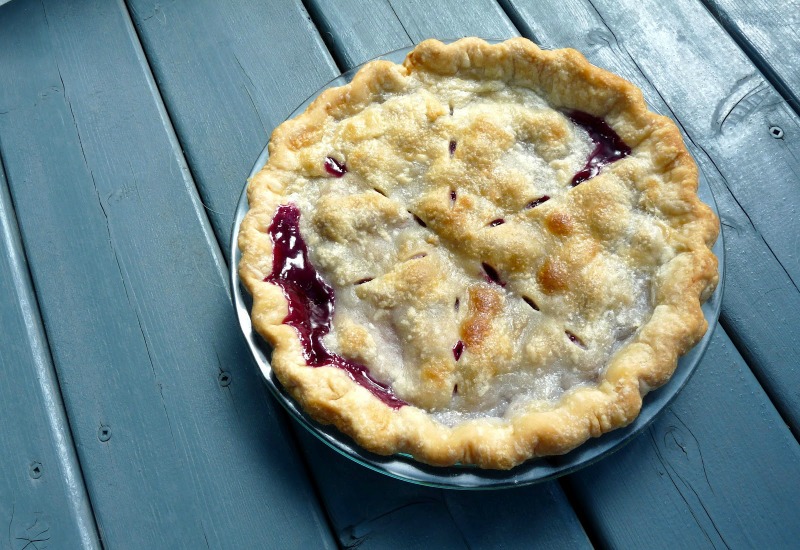
Saskatoon Berry Pie. Photo courtesy Edible Life in YYC.
Modern prairie life boasts all the comforts, but back when the Canadian prairies were newly settled, the extreme climate made for some pretty tough times. A lot of crops that grew easily elsewhere in the country simply couldn’t survive the harsh winter and dry summers, so early Alberta, Saskatchewan and Manitoba residents had to make do with a less diverse menu. But they endured, and eventually, they thrived, and can now boast about some great culinary traditions.
The prairies, in addition to growing a lot of wheat, also turned out to be very well suited to grazing cattle. Thus beef is a significant export, so you needn’t be in the area to get your fork into some top-notch Alberta Beef. But Albertans certainly do enjoy lots of it!
Avoiding scurvy used to be critically important in any region without citrus fruits and settlers on the prairies would have been pleased to learn about a source of Vitamin C that the indigenous residents were already well acquainted with: the Saskatoon Berry. Looking a little like a blueberry, but sporting a chewier texture due to its pithy centre, Saskatoons are now grown commercially and are a popular filling for summer pies.
Calgary, Canada’s largest prairie city (and my adopted home) gears up all year long for its annual Calgary Stampede and, while not fancy, the pancakes served at the many (so, so many!) Stampede breakfasts are associated with Calgary’s knack for down-home hospitality and are therefore often considered to be an essential part of our culinary heritage. Further north, Edmonton (Alberta’s capital city), is home to many people of Eastern European descent; pierogi (or perogies) and kielbasa sausage are a staple there.
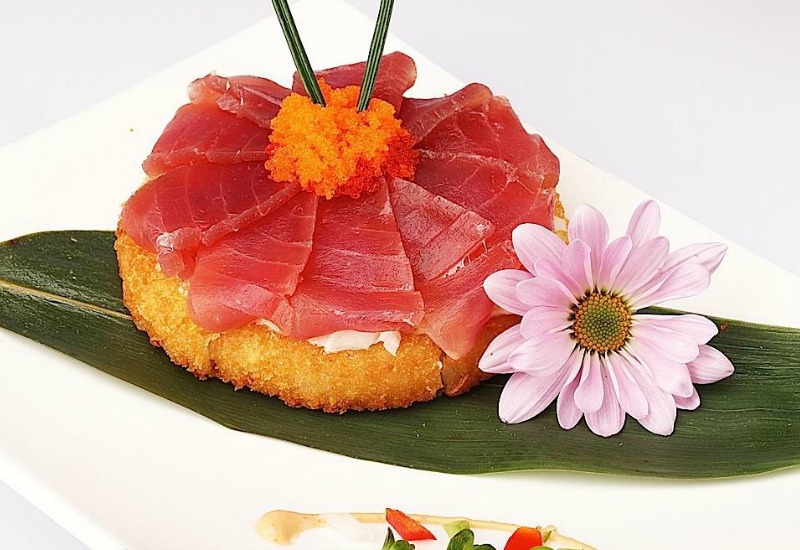
Tuna Sushi Pizza. Photo courtesy Sushi Rock – Toronto.
The geographic and political heart of Canada – home to our capital city, largest city and largest provincial population – Ontario is where the Canadian west meets its east. With culinary influences from both directions, an optimal agricultural climate and the large numbers of immigrants from around the world who now call this area home, Ontario boasts an eclectic food scene.
Southern Ontario’s excellent growing conditions mean that area residents enjoy fabulous seasonal produce. Corn on the cob, fresh berries and apples are all local crops not to be missed. In fact, any autumn visit to this part of the country should include at least one trip to an apple farm like Chudleigh’s or Carl Laidlaw Orchards. When you just can’t eat another crisp, juicy apple in the raw, turn some of your hand-picked bounty into a pie or crisp. Don’t forget the vanilla ice cream; it’s traditional.
Whatever the origins of sushi pizza – apparently a Montreal sushi chef claimed in the 90’s that she invented it, but the claim is not possible to prove – sushi restaurants in Toronto have wholeheartedly embraced this fusion dish and it is now well known as a T.O. ‘thing’. This delectable concoction consists of a deep-fried sushi rice ‘crust’ topped with classic or avant-garde sushi ingredients. Every sushi fan owes it to themselves to give this variation on the rice-and-fish theme a try.
Ottawa is home to our federal government and – perhaps nearly as importantly – to BeaverTails. This homegrown pastry, named after the critter whose tail shape it resembles, was invented in Ottawa in 1978. Back in the day, cinnamon & sugar were the classic toppings (and are still my favourite), but you can now get just about anything on yours, including chocolate hazelnut spread topped with Reese’s Pieces and peanut butter – this is known as a Triple Trip and I think I can see why. May I gently recommend a workout after you eat one of those?
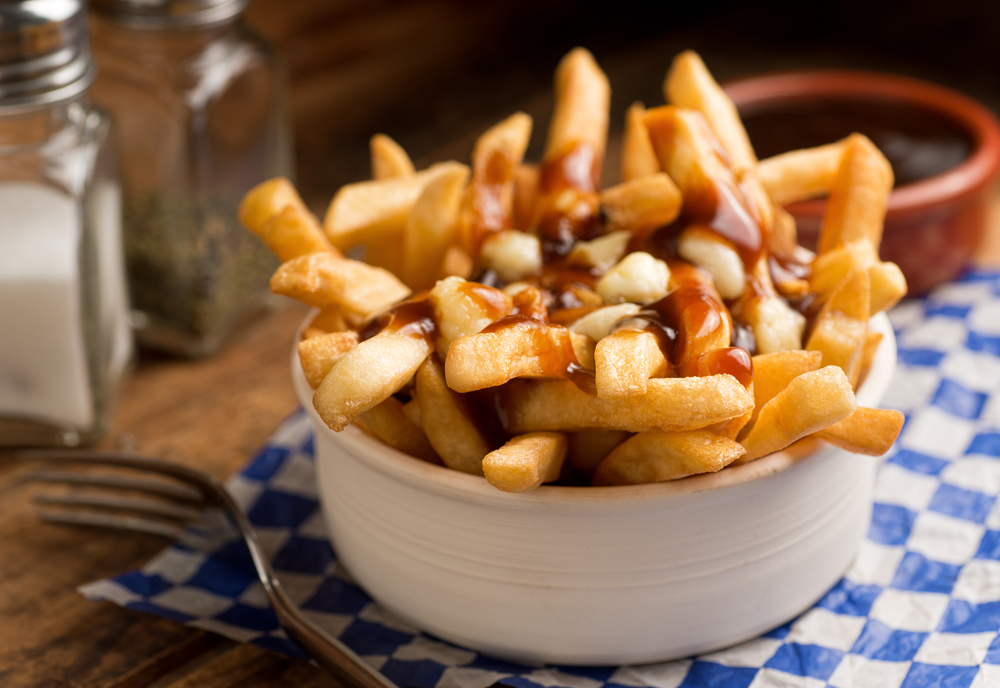
Poutine via Shutterstock.
Heading from Ontario into Quebec, local food becomes more influenced by the province’s French heritage. Cheese producers abound, some of the world’s best maple syrup literally grows on tree (ok, in trees) and comfort foods like tortière (spiced meat pie), French Canadian pea soup (soupe aux pois) and baked beans (fèves au lard) can help a person survive through a bitterly cold Quebec winter. Never mind that everyone now has central heating, Quebecois comfort foods are delicious. Just be sure to shovel some snow or skate on a frozen pond after the richer ones.
So, what’s the deal with Quebec’s arguably most famous food, poutine? The combination of cheese curds and gravy on french fries has never struck me as particularly French, so I googled its history. It turns out nobody knows precisely who originated the dish, but everyone seems to agree that it has its roots in rural Quebec sometime in the 1950s. Cheese producers in the area might have been looking for an outlet for their supply of cheese curds, and perhaps the gravy was added to keep the whole thing from seeming a bit dry. Whatever the original reasons for combining these particular ingredients, poutine has been widely embraced throughout Canada and even internationally. Poutine has now gone gourmet, with chefs trying out additions and substitutions from many global cuisines. But like most cult classics, you’ll find a lot of different – and strongly voiced – opinions about what constitutes the perfect poutine.
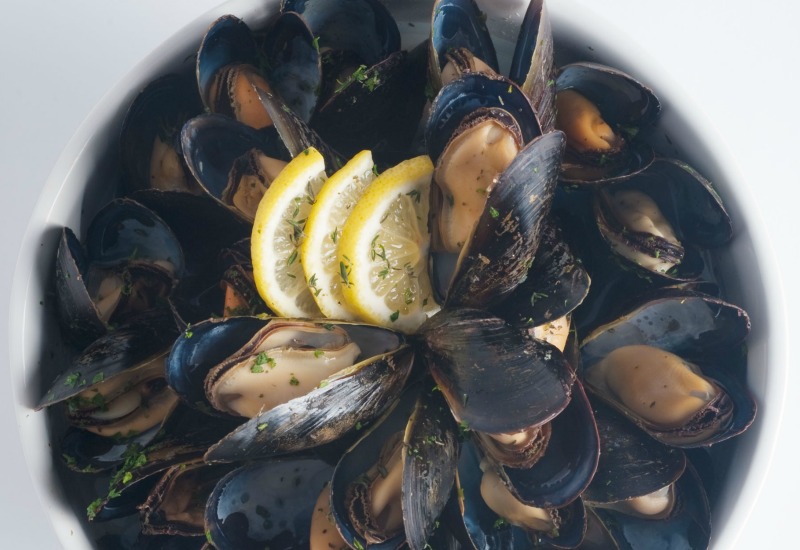
PEI Mussels. Photo courtesy PEI Mussels.
Do you have another virtual toe ready? This time we’re going to dip it into the Atlantic Ocean, as we take a bite out of the Maritime Provinces and Canada’s east coast. Disclaimer: I have never been to our eastern provinces, but I am excitedly anticipating my first trip to Cape Breton Island, Nova Scotia, in less than two weeks. According to my research, these are some of the foodie highlights of the area and I hope to try them all and then some.
Did someone say seafood? Of course! Being a coastal area, seafood has long been an important part of Maritime cuisine. Nova Scotia boasts some of the best lobster harvesting beds in the world and PEI has taken advantage of its clean waters and technical know-how to develop a significant mussel industry. But not all of the ocean’s bounty is of the critter persuasion and for a vegan ‘seafood’ option, dulse is commonly eaten (dried to a crisp) as a salty snack.
With skyrocketing food prices, it’s hard to imagine anybody eating enough lobster to get sick of it, but apparently that used to happen in coastal communities. Perhaps it still does? I’ll try to remember to ask when I’m in Nova Scotia. Residents certainly needed other foods in their diets too. PEI has long been a big potato producer, and folks in Nova Scotia reportedly mix potatoes and seasonal vegetables with a milk broth to create a veggie casserole locally known as Hodge Podge, which is often served with corned beef.
Blueberries grow wild in many parts of the Maritimes and so a local meal might come to a sweet conclusion with a bowl of blueberry grunt, which someone from elsewhere might refer to as a cobbler. Either way, it sounds delightful.

Nova Scotia lobster dinner. Photo courtesy Taste of Nova Scotia.
Canada is a vast country. Most of us will never get to travel coast to coast in a single trip. Some will never manage to visit both coasts. Happily, most of the delicious foods that make up our Canadian culinary identity have now made their way from their original source to the rest of the country. You can enjoy poutine in Vancouver, a BeaverTail in Banff or PEI mussels in downtown Toronto. But you don’t need to eat out to enjoy great Canadian dishes. This Canada Day, why not celebrate by creating an all-Canadian menu at home? One of the fantastic cookbooks from Whitewater Cooks can help you create a memorable meal!
We’ve only scratched the surface of Canadian cuisine here; there’s so much more to explore. Help us out – what are your favourite foods that you perceive to be Canadian and/or regional? Restaurant and recipe recommendations are also welcome!




